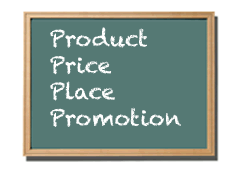EZIPOP in the Marketing Mix
"Build a better mousetrap and the world will beat a path to your door!"
 Unfortunately it's not as simple as that.
Unfortunately it's not as simple as that.
Products are goods or services that an organization sells to their customers
A Product should supply a need that customers have or might believe they have, if they're exposed to it’s benefits. Customers may want to know things about the product like it’s technical features, how it might fit into their particular lives or how it may improve their lives. Things like available colours, size, how it compares with other similar products or services but importantly, what it will do for them.
Price is the cost to the buyer of goods and services
Price is the cost to the consumer to own your product. Customers will want to know how much an item costs, which may involve quantity and volume discounts. A service may be charged out at an hourly rate, so they will want to know that hourly rate. Are there any discounts available, how does the price compare to other known products or services. Is your product of a different quality or is it technically superior to others on offer, so that it could justify a higher price?
Place is where goods or services are available
Your customers will need to know where your product or service is available. Will it be available in a store near them, will they be able to buy it on-line, is it only available in specialized stores, which might make it inconvenient for them? Is the service on offer only available in certain locations or is it available everywhere your customers are?
Promotion is informing potential customers about the organisation’s product or service and persuading them to purchase
Your customers need to be informed about your particular product or service and this may be achieved through mass advertising using media such as TV, radio, magazines and newspapers, through to billboards etc. Some products may suit advertising on suitable websites or social media. Press releases, public relations campaigns, direct mail, sampling, 2 for 1 offers etc. are used to inform the customer and generate interest in purchasing your product or service.
Over 70% of purchase decisions are made at POP
According to POPAI, The Point Of Purchase Advertising Institute, the generally accepted figure based on solid research, is that over 70% of purchasing decisions are made at the point of purchase. In a recent study, they found this to be as high as 75% of decisions being made right there in store, where the particular good or service was on offer. And some of those decisions are made without any prior knowledge of the product or service on offer.
After you have your product correctly designed to suit your target market, you have priced it correctly, you have it available in all the right locations relevant to your particular product or service and you have promoted it in the most appropriate way, what happens at the point of purchase is the most relevant. Your customers are bombarded with information on a myriad of products and services, some of which they will ignore because it isn’t appropriate for them at that time or in their particular circumstances. When a company has launched a new and improved washing powder for example, the last and most important thing they will want to do is make a visual splash at the spot where the washing powders are displayed on the shelf in store.
Then if all of their other promotional efforts have cut through, the customer is reminded once more of the reasons why they should pick that product up and try it. It may be a splash on the packs that announces the key words from the advertising and promotion of that washing powder, it may be an end of aisle display that draws attention to the product, or it may be a shelf wobbler or other device to draw attention and trigger a memory of advertising information previously absorbed.
Provide information where it's needed
Some products, typically a higher priced item or service may need more consideration by the customer, so the point of purchase (POP) used may be personal selling, or it may be an information leaflet displayed at the point where the product is shown. A brochure promoting a service may be displayed on the main counter, next to the cash register or POS terminal because it isn’t a physical product. An internet service, a phone company, a lawn-mowing service etc. needs to get their printed literature in the hands of the potential customer.
EZIPOP brochure holders have been successfully used by many clients to disseminate their information, leading to sales of their particular product or service. Brochures or leaflets left lying around on a shelf can easily be missed, or become untidy or dog-eared. Displaying your information in a custom printed EZIPOP, presents your product or service professionally and in an easy way for customers to access that information.
EZIPOP product dispensers have been used successfully to promote new products, because of their eye-catching presence at POP and the invitation to remove a package easily from the front dispensing slot. Some products benefit from allowing customers to trial a sample pack and this is another way how EZIPOP product dispensers can be successful.
The unique and patented construction of our EZIPOP products imparts that WOW factor when they are popped up on a counter or shelf, often overcoming any resistance by store management to displaying information leaflets.
 Unfortunately it's not as simple as that.
Unfortunately it's not as simple as that.